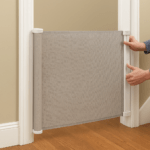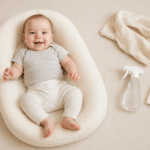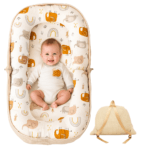Introducing solid foods to your baby marks a significant developmental milestone and part of this transition involves considering when they’re ready for a high chair. “Safety First: When Can Baby Sit in a High Chair?” delves into this crucial aspect of your baby’s feeding journey. It’s not just about age; it’s about readiness. This article navigates the indicators of physical and cognitive readiness, ensuring that your baby is not just seated but seated safely. We’ll explore the signs that signal your baby is ready to join the family at the table and the safety considerations to keep in mind when selecting and using a high chair.
By understanding the developmental cues and taking the necessary precautions, you can ensure that mealtime becomes a joyous and secure experience for you and your little one.
So, let’s explore the world of high chairs and discover when your baby can safely sit at the table.
Importance of baby high chairs
Baby high chairs play a crucial role in infant feeding and development, offering a safe and comfortable space for babies to explore solid foods alongside their families. These chairs are more than just furniture; they provide a designated space for infants to join mealtime rituals, fostering social interaction and family bonding from an early age.
One key benefit of high chairs is their elevated design, which brings babies to the same level as adults during meals. This allows for easier feeding and promotes eye contact, communication, and socialization between parents and their little ones.
Moreover, high chairs provide a secure environment for babies to practice and develop their sitting skills. As infants gradually gain control over their bodies, the supportive structure of high chairs helps them learn to sit independently, strengthening their core muscles and improving their overall stability.
Read to know more: Baby Trend Car Seat Installation: Beyond the Basics
About Newborn Baby and High Chair
The focus is primarily on safety and readiness for newborn babies and high chairs. Newborns typically rely on breastfeeding or bottle-feeding, so high chairs aren’t immediately necessary. However, introducing a high chair becomes relevant as babies age 6 months and begin transitioning to solid foods. At this stage, babies start showing signs of readiness for sitting upright and exploring new textures and tastes.
While traditional high chairs may not be suitable for newborns due to their limited mobility and developmental stage, there are alternative options, like reclining high chairs or portable booster seats with infant inserts. These options offer a safe and supportive environment for babies to gradually experience sitting at the table during feeding times. Prioritizing safety and comfort is essential when selecting a high chair or alternative seating option for newborns, ensuring a smooth and enjoyable transition to solid foods as they grow.
Developmental Readiness for Using a High Chair

Introducing a high chair to your baby’s feeding routine involves considering their developmental readiness, which encompasses physical and cognitive milestones.
Physical Milestones
Physical development is crucial in determining whether a baby can use a high chair. Key milestones include:
Head Control: Babies should demonstrate the ability to hold their heads steady and upright without support. This indicates that strengthening neck muscles is essential for sitting upright in a high chair.
Sitting Stability: Babies should be able to sit with minimal support and maintain balance without toppling over. Developing trunk control and stability is essential for comfortably seated in a high chair.
Coordination: Babies should exhibit coordination and control over their movements, particularly hand-to-mouth coordination. This skill is crucial for self-feeding and exploring different food textures.
Cognitive Readiness
Beyond physical development, cognitive readiness is essential for effectively using a high chair. Signs of cognitive readiness include:
- Interest in Food: Babies should show curiosity and interest in food, often demonstrated by reaching for or showing excitement when presented with food items.
- Engagement During Mealtime: Babies should demonstrate engagement during mealtime, showing eagerness to participate in feeding activities and interact with caregivers.
- Understanding Feeding Cues: Babies should be aware of feeding cues, such as opening their mouths when presented with food or showing signs of hunger or fullness.
Age limit
Determining the opportune moment to introduce a high chair to your baby revolves around multiple factors, chiefly their developmental milestones and readiness for solid foods. While there’s no definitive age, general guidelines offer helpful insights. Typically, around 6 months marks the commencement of introducing solid foods to babies. This phase, known as weaning, involves supplementing breast milk or formula with pureed or mashed foods to meet growing nutritional needs. A pivotal aspect of gauging the ideal age for a high chair is your baby’s capability to sit autonomously. By approximately 6 months, many infants have developed ample trunk control and stability to sit upright with minimal assistance. This milestone is vital for ensuring the safe and comfortable utilization of a high chair during mealtime.
Is a high chair suitable for babies?

Yes, high chairs benefit babies as they provide a safe and supportive environment for mealtime. High chairs offer several advantages:
- Safety: High chairs are designed with safety features such as harnesses and sturdy construction, reducing the risk of falls or accidents during feeding sessions.
- Independence: High chairs allow babies to sit upright and participate in mealtime activities independently, fostering a sense of autonomy and self-confidence.
- Socialization: Sitting in a high chair brings babies to the same level as adults during meals, promoting eye contact, communication, and social interaction with family members.
- Development: Using a high chair helps babies develop essential motor skills, such as reaching for food and self-feeding, as well as improving their posture and stability.
Is it Bad to Put a Baby in a High Chair Too Early?
Putting a baby in a high chair too early can have negative consequences. High chairs are designed for infants who have achieved certain developmental milestones, typically around 6 months of age. Placing a younger baby in a high chair before they possess adequate head and trunk control can lead to discomfort and safety risks, such as slumping or sliding. Moreover, premature introduction to a high chair may result in a negative feeding experience, potentially causing frustration or aversion to mealtime for both the baby and the caregiver. It’s crucial to wait until your baby demonstrates readiness for solid foods and independent sitting before transitioning to a high chair.
By ensuring your baby is physically and developmentally prepared, you can promote a safe and positive feeding experience, fostering healthy eating habits and enjoyable family interactions.
So, At What age and Why can I put my baby in a high chair?
You can typically start putting your baby in a high chair around 6 months. This age is commonly recommended because it aligns with the introduction of solid foods and the developmental milestones needed for safe high chair use. By 6 months, most babies have developed sufficient head control, trunk stability, and sitting skills to sit upright in a high chair without support. However, every baby is unique, so it’s essential to consider your baby’s readiness factors. Watch for signs such as the ability to sit with minimal assistance, interest in food, and coordination of hand-to-mouth movements.
If your baby shows these signs before or after 6 months, it may be a suitable time to introduce them to a high chair. Always prioritize safety by selecting a sturdy high chair with appropriate safety features, and never leave your baby unattended while they are in the high chair.
How long can a baby sit in a high chair?
The length of time a baby can sit in a high chair varies depending on age, temperament, and developmental stage. Generally, babies can sit in a high chair for around 20 to 30 minutes during a mealtime session. However, being attentive to your baby’s cues and comfort level is essential. Some babies may become restless or fussy after a shorter period, while others may happily sit longer.
As babies grow and become more accustomed to sitting in a high chair, they may gradually extend their sitting duration. It’s essential to monitor your baby’s posture and ensure they remain comfortable and well-supported throughout their time in the high chair. Additionally, engaging your baby with interactive toys or offering small, manageable food portions can help keep them entertained and content during mealtime. Remember to always supervise your baby while they are in the high chair and never leave them unattended.
Choosing the right high chair for your baby
Choosing the right high chair for your baby is essential for their safety, comfort, and enjoyment during mealtime. Here are some factors to consider when selecting a high chair:
- Safety Features: Look for a high chair with a sturdy and stable design to prevent tipping. Check for safety features such as a secure harness or seat belt to keep your baby strapped during meals.
- Adjustability: Choose a high chair with adjustable height and recline options to accommodate your baby’s growth and changing needs. Adjustable trays and footrests can also provide added comfort and support.
- Ease of Cleaning: Opt for a high chair with removable, easy-to-clean seat covers or cushions. Smooth, wipeable surfaces make cleaning up spills and messes simple, ensuring a hygienic eating environment for your baby.
- Compact Design: Consider the size and footprint of the high chair, mainly if you have limited space in your home. A compact, foldable design can make storage and transportation more convenient when not in use.
- Durability: Choose a high chair made from durable materials that can withstand daily use and last through multiple children if needed. High-quality construction ensures long-term reliability and safety for your baby.
- Comfort: Look for a high chair with a padded seat and supportive backrest to keep your baby comfortable during meals. A footrest can also provide additional support and promote proper posture.
- Reviews and Recommendations: Research high chair options online and read reviews from other parents to gather insights and recommendations. Pay attention to feedback regarding safety, durability, and ease of use.
How can I make mealtime enjoyable for my baby in the high chair?
Making mealtime enjoyable for your baby in the high chair involves creating a positive and engaging environment. Here are some tips to help:
- Offer a Variety of Foods: Introduce various colourful and nutritious foods to spark your baby’s interest and encourage exploration. Include a mix of textures and flavours to keep mealtime exciting.
- Engage in Conversation: Talk to your baby during mealtime, describing the foods you’re offering and encouraging them to communicate with babbling or gestures. This interaction helps build language skills and strengthens the parent-child bond.
- Use Fun Utensils and Plates: Choose utensils and plates with vibrant colours or playful designs to capture your baby’s attention and make mealtime more enjoyable. Child-friendly utensils with easy-to-grip handles can also encourage self-feeding.
- Create a Positive Atmosphere: Keep mealtime relaxed and enjoyable by minimizing distractions and focusing on the experience of eating together. Avoid rushing or pressuring your baby to eat, allowing them to explore and enjoy their food at their own pace.
- Offer Praise and Encouragement: Celebrate your baby’s efforts and successes during mealtime with praise and encouragement. Positive reinforcement can boost their confidence and make them more eager to participate in future meals.
- Incorporate Fun Activities: Introduce simple activities or games during mealtime, such as singing, playing peek-a-boo, or making funny faces. These playful interactions can make mealtime more engaging and enjoyable for your baby.
Safety Considerations
Safety considerations are paramount when selecting and using a high chair for your baby. Here are some essential safety factors to keep in mind:
- Stability: Choose a high chair with a broad and stable base to prevent tipping over. Ensure that the chair remains sturdy and secure, even when your baby is moving or leaning.
- Harness or Seat Belt: Look for a high chair equipped with a reliable harness or seat belt to secure your baby in place during mealtime. Ensure the harness is adjustable and adequately fitted to restrain your baby safely.
- Safety Standards: Verify that the high chair meets safety standards set by regulatory organizations. Look for certification labels or indications of compliance with safety regulations to ensure that the chair has undergone rigorous testing for durability and stability.
- Check for Recalls: Research any recalls or safety alerts associated with the product before purchasing a high chair. Check the manufacturer’s website or consumer safety databases to ensure the high chair is free from any safety concerns.
- Supervision: Never leave your baby unattended in the high chair, even temporarily. Always supervise your baby closely during mealtime to prevent accidents or injuries.
- Proper Use: Follow the manufacturer’s instructions for the high chair’s assembly, use, and maintenance. Ensure all components are correctly installed, and the chair is used according to its intended purpose.
- Cleaning and Maintenance: Regularly inspect the high chair for signs of wear or damage, such as loose screws or torn seat covers. Clean the high chair regularly, paying particular attention to areas where food may accumulate to prevent bacterial growth and maintain a hygienic eating environment for your baby.
FAQs
How do I know if my baby is ready for a high chair?
Look for signs of readiness, such as sitting with minimal support, showing interest in food, and demonstrating hand-to-mouth coordination.
What safety features should I look for in a high chair?
Prioritize stability, a secure harness or seat belt, compliance with safety standards, and regular maintenance to ensure safety.
When should I transition my baby from a high chair to a regular chair?
Watch for signs of independence, such as sitting unsupported and showing interest in joining family meals. Gradually transition them as they become ready.
How can I make mealtime enjoyable for my baby in the high chair?
Offer a variety of foods, engage in conversation, use fun utensils, maintain a positive atmosphere, offer praise, and incorporate fun activities.
Is it wrong to put my baby in a high chair too early?
Yes, premature introduction can pose risks such as discomfort and safety hazards. Wait until your baby demonstrates readiness for solid foods and independent sitting.
Conclusion
Choosing and using a high chair for your baby involves careful consideration of safety, comfort, and developmental readiness. By selecting a high-quality chair, prioritizing safety features, and creating a positive mealtime environment, you can ensure a safe and enjoyable dining experience for your little one. Remember to supervise your baby closely during mealtime and follow safety guidelines to promote healthy eating habits and foster family bonding.















